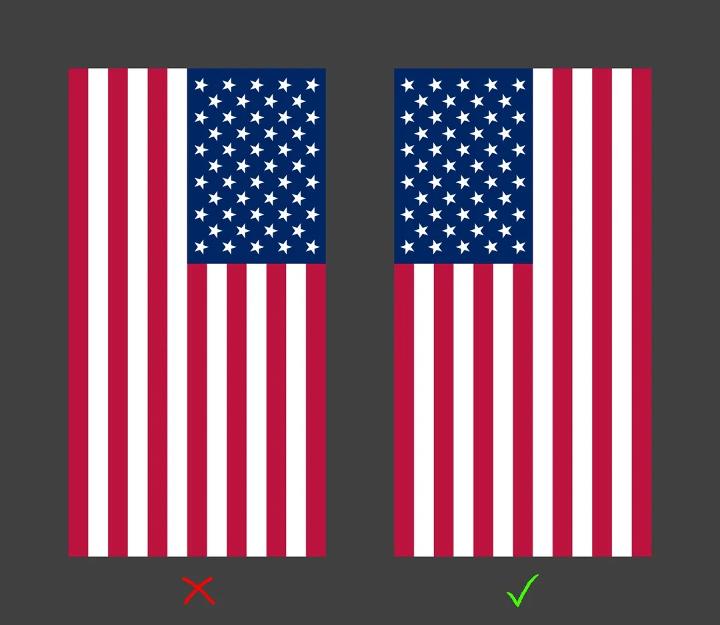Hanging the American flag has history and respect as its basis. Whether it is a national holiday, family gathering, or just to show some appreciation for the country, this piece of information will definitely prove helpful on how to hang a flag vertically in the United States of America. Now, let's check out the proper way to hoist your U.S. flag at home.
What is the Flag Code?
The U.S. Flag Code is the set of regulations defining the way the American flag is to be treated and displayed. However, the code has no law behind it. Since it is not codified under the law, it lays down the standard of respect as well as honor towards one's country’s emblem. As one who has a special feeling for flags, I learned from it that following the flag code demonstrates the love meant to citizens by a nation.
Key Principles of Respect and Honor
When displaying the flag, keep in mind the following principles:
- Fly it Right: It must always be flown with the stars at the top left from a spectator’s view. If shown vertically, this is highly significant.
- Time Considerations: The flag can be displayed from sunrise to sunset, and if displayed otherwise at night, it will need to be illuminated.
There must be no attachment on the flag. It has to be hoisted in its pure form and without any logos or any attachments whatsoever.
When to Hoist the Flag Vertically?
Literally, there are hundreds of occasions when you will want to display your flag. While it is most certainly most popular during Independence Day, Memorial Day, and Veterans Day, it is also used at family reunions and when you graduate from high school.
Displaying it year-round does have considerations. It is marvelous to drape your flag on national celebrations, but most people take pride in its display always. Once you make this decision, you ensure that your flag is pretty strong for it to last longer in weather conditions.
It is tough living in a state known for its changeable weather. Several years ago, I had a customer buy weather-resistant flagging for the coastal home he had coming up. Something that does not fade to white overnight in the sunlight and it stays intact from a gusting wind. High quality will always pay for itself over a long period.

How to Properly Hang the Flag Vertically?
Materials Needed:
To hold your flag upright you will need the following;
- Flag: There are flags that are sturdily made; and nylon or polyester flags for that matter, can as well withstand very harsh conditions.
- Flagpole or Mount: This is mainly dependent on the mounting procedure in place; it might either be a wall mount, or a conventional pole; make sure it is sturdy enough to hold the flag in place.
- Optional Accessories: The flag should have accessories such as lighting that shows at night or even a bracket to stabilize.
Choosing the Location:
And of course, think about part of your house would be easy to view from far away. By experience, the front part is the best viewing spot, provided it does not have any trees or power lines that may hinder the view.
- Visibility considerations: Look for a location that is visible from the street or from your yard. In general, you really cannot go wrong with the front of your house.
- Avoid Obstructions: Trees, electric lines, or anything in that light should not block the line of sight for the flag.
- Ideal Display Sites: Hang a flag high Visible and inviting display to the house.
I normally advise people to install the flag in a prominent position from the street as it makes your house welcoming, and people passing there may be attracted to stop and appreciate it.
Installing the Flagpole Securely
Having selected the site, it is now time to attach the flagpole. Ensure it is well anchored to the winds and other elements. With wall mounts, ensure that you drill into a stud for stability.
Attaching the flag using adhesive mounts could look beautiful but when you put it up, within a couple of windy days, it can come crashing down. This is how you can avoid such embarrassing moments—learning how to use the right tools in installing your flag.

Techniques for Attaching the Flag
Now comes the best part: attaching the flag. Here’s the proper way to do this:
- Orientation: When you hang the flag vertically, it should always be such that you observe the stars in the left-hand top corner as seen. This is paying honor to the design of the flag and what it implies.
- Tucking it Tight: You want your flag to be the best looking, and you can keep it this way by tucking it tight. In this case, it flaps minimally when it is in the wind but looks fantastic.
Your flag can sag because it has not been tightened well. And once you tighten it, it will make all the difference between night and day; transforming what otherwise would have been a pretty lackluster show into a real showstopper.
Conclusion
Showing your U.S. flag upright in your home is more than just an ornament; it is a way of showing respect to a symbol of our liberties and values. The U.S. Flag Code has guidelines that will help you make sure your display reflects the respect this emblem deserves.
Whether you are getting ready for a holiday or just want to express your patriotism, remember the right materials, how to hang them, and always track the weather. Each time I see a flag properly displayed, it reminds me of the common pride we all feel about this great country. So go hang that flag! It is so much more than some cloth; it is heritage and unity.
Every Patriot's Handbook on How to Hang a Flag Vertically in America